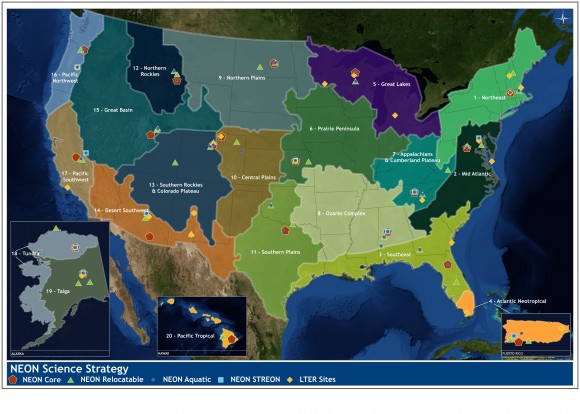LTER and NEON are highly complementary networks that support ecological research in different ways, but are becoming more and more integrated over time.
NEON is a continental-scale infrastructure facility providing physical and data resources to researchers and educators. LTER is a network of long-term research projects aimed at understanding processes in a wide range of ecosystems. While the NEON observatory sites were selected to cover U.S. ecological variability according to defined criteria, LTER sites are selected on a site-by-site basis chosen based on the intellectual importance and insight of the questions proposed for that site. LTER has consensus network core research areas (e.g., understanding patterns and controls of net primary production) but site-and-PI-specific research approaches are used to carry out common research goals. LTER research is primarily site-based to regional, whereas NEON addresses a narrower set of questions at regional to continental scales using common infrastructure and protocols across sites.
NEON and LTER have worked together closely in many ways:
- Many LTER scientists participated in NEON’s early planning and brought insights into issues they wanted to study, but could not within the structure of LTER.
- Many NEON sites are co-located with LTER sites and complement the existing LTER infrastructure. • LTER and NEON are collaborating on the development of ecological informatics and members from each network serve on each other’s working groups and planning teams.
- NEON has developed an urban observing network addressing issues and questions largely arising from work done in the Urban LTER sites, but adding a standardized set of long-term instrumental and biological measurements to enable comparative studies between cities and across urban to rural gradients.
Now that NEON is entering the construction phase, there are many other ways in which the LTER science community and the NEON facility can interact in the future. The close involvement of LTER scientists in NEON’s technical working groups will infuse many of the lessons learned from LTER into NEON’s implementation, while at the same time giving LTER scientists insight into NEON’s scientific, education and outreach capabilities. Both programs provide critical infrastructure to researchers in NSF’s new Macrosystems Biology program, and the observations, facilities and informatics from the two programs will power a new generation of exciting work by the broader research community. As the NEON taskable facilities come on line, such as the Airborne Observing Platform, these capabilities will be available for use by LTER and non-LTER scientists alike.
Going forward, the two programs will plan joint research, education, and informatics workshops, intensified involvement in each other’s organizational committees, and scientific working groups. This will lead to further synergistic integration and increased collaboration between these two large-scale, long-term networks.


 Enlarge this image
Enlarge this image
